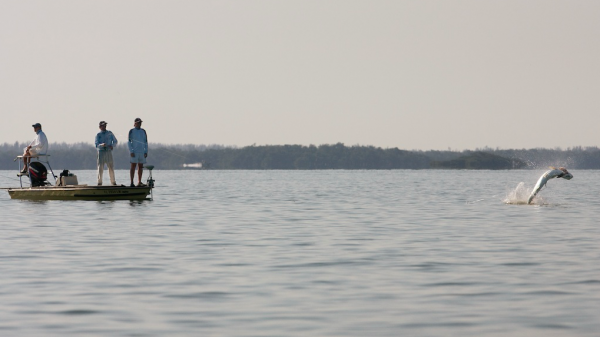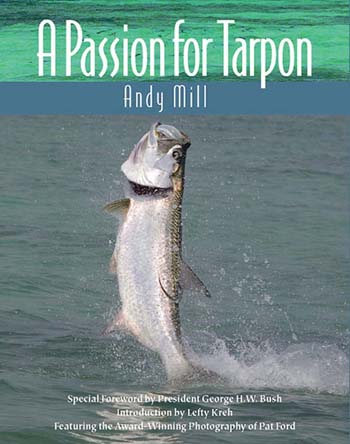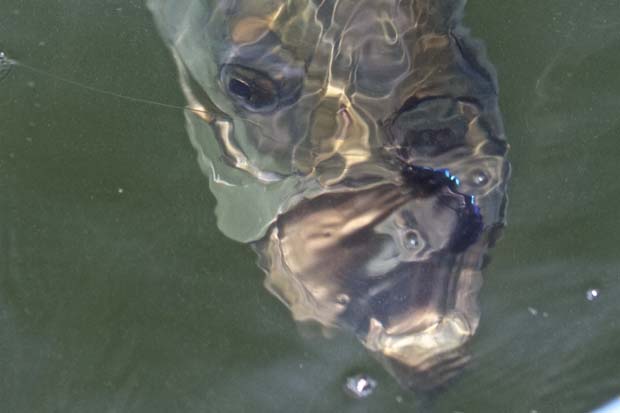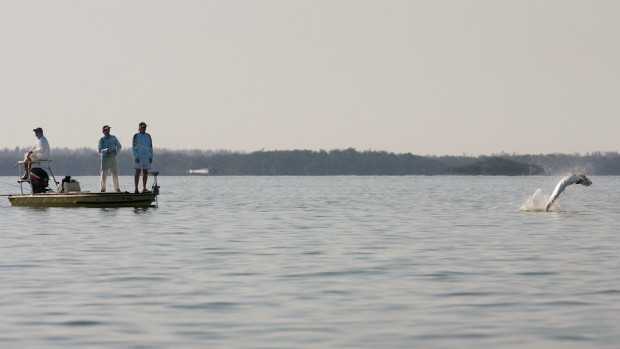Introduction by FLM staff.
[dropcap]I[/dropcap]n this hemisphere, it’s possible that Andy Mill knows as much about tarpon catching as anyone dead or alive – spin or flies. In this story on advanced fly fishing for tarpon, we’ll draw on his hard-earned knowledge. Knowledge that he served up to readers in his award-winning book called A Passion for Tarpon.
If you have a passion for tarpon, we can promise you that you’ll take away from this single chapter enough to make you a better tarpon angler and, especially so, if you’re an angler with big ‘poons on the mind.

Photo: D. Gulden. Angler Andrew Derr guided by Captain Zeke Sieglaff in Boca Grande, FL.
Big tarpon can be a fickle thing when presented with a fly. She may turn away from it, sit-tight and stare at it, follow it right up to the boat or absolutely massacre it and put on the show of a lifetime. Making the latter happen is a combination of luck, choosing a fly of interest, great casting, having the fly in the right water column, properly setting the hook, fighting the fish properly, landing it as quickly as possible and making a safe in-water release. The devil, however, is in the details of doing – so let’s examine how Andy gets there.
Part Three ~ Feeding the Animal
By Andy Mill

Andy Mill’s book won several awards. Looking for the perfect Father’s Day gift? To order a copy click here
Materials used in the construction of tarpon flies make a huge difference when the fly must be slowed down to keep the fish from getting to close to the boat. Most of the materials I use are marabou and rabbit fur. It’s remarkable how alive these flies look just sitting there motionless in the water. Sometimes a fish lies suspended behind your fly, watching it with great scrutiny. Because of the fluidity of material, many times I hook fish in such a situation by doing nothing-on purpose. Look closely at a quill of marabou or a rabbit strip and notice how many soft flexible fibers there are. Once saturated and left dangling in the water, these fibers come alive in continuous motion. If I sense it’s needed, I can impart more action just by shaking my rod tip.
I rarely give life to my flies with my stripping hand. I slide the fly forward by moving the fly line forward with a long, smooth stroke with my strip-ping hand but I create the undulating movement I want my fly to make with my rod tip through my rod hand. This is an important distinction.
If the flies you are using mimic baitfish such ballyhoo or mullet, it is instructive that the tails of these species move back and forth horizontally, not vertically. Therefore, when I slide the fly forward with my stripping hand, I simultaneously shake my rod tip horizontally to give the tail of the fly the same action or movement. About the only time I use my stripping hand to breath life into the fly is when I’m throwing shrimp patterns. The reason is simple: real shrimp jump vertically and quickly when they’re trying to get away. Sharp, quick bumps with the stripping hand mimic this movement perfectly. We’re talking four- to five-inch bumps here, sometimes shorter.
Another effective way to strip is with two hands. Once the cast is made, place the rod handle under your armpit. Now you can strip the fly withtwo hands, creating continuous motion. This is extremely effective with a number of fly patterns, especially imitations of palola worms, which skirt quickly and continuously about. If you need the retrieve to be faster you can accelerate with two hands easily and effectively. This is also deadly while fishing for other game fish-Bonita, barracuda, billfish and others-that like a fast, non-stop retrieve.

Airborne! Image by Capt. Greg Dini.
Also, when you’re stripping with two hands and the fish eats the fly, you won’t have to worry about yanking the fly out of the fish’s mouth with a trout strike-a cardinal sin in tarpon fishing. It’s a common mistake we all make at times but one that particularly plagues anglers new to tarpon fishing. When you see that huge mouth open to bite your bug, believe me, it’s hard not to lift your rod and rip the fly out of the poon’s mouth. After 20 years I still do it on occasion. Harry Speer and I came up with a valuable phrase way back when: DON’T STRIKE YOUR ’POON TOO SOON!
Another valuable dividend is that while stripping with two hands and you happen to strip the fly out of his face, the fly is still in the water directly in front of him. There’s a great chance the fish will eat the fly again. Many, many times I’ve seen-and caught-fish repeatedly trying to eat my fly. Usually the second time they eat it they destroy it, angered that they missed it the first time or afraid they’ll miss it again.
There are times when trying to feed tarpon by doing nothing with the fly is more effective. There’s an area behind Islamorada on the bay side that extremely large tarpon call home. The water is clear. Fish slide around on the bottom dragging their bellies over the sand. They also lie up on top with their tails sticking out, in the middle of the water column. They lie stationary on the bottom as well.
I’ve caught these fish using a variety with baby bumps and tweaking. It all depends on the pattern I’m using and what the fish are doing. On occasion, though, doing nothing with the fly other than picking up the slack in the fly line and allowing the fly to sink naturally is the best bet for a grab.

Game over – at the gunnel.
Image by Capt. Greg Dini.
What works best when the fish are laid up mid-column and higher? To tell you the truth, it varies. Some days small baby bumps close the deal. Another scenario is to do nothing with the fly. Put the fly about three to four feet in front of the ’poon. Then just pick up the slack of the fly line and let the bug sink. Often they slide over and sip the fly as if they’re licking an ice cream cone. When they’re in this mood I’ve made the mistake of bumping the fly upon their approach, and when I do they immediately duck. You’ll soon know after they do this a few times that they’re in the mood for a dead-sink presentation.
The other situation where less is more (and I spoke of it in detail in chapter 7, Reading the Fish) is when the ’poon is laid up in cold water. The difference here is the fly must sink down the fish’s forehead because they’re too cold to move. Watch carefully for the subtle sucking or inhaling of your fly when they bite it.
To hone your skills to the level of proficiency that you are able to catch the fish that doesn’t want to be caught, be obsessively observant. Pay attention to everything. Study your prey. And think. The more idiosyncrasies you know about the behavior of the fish and the tackle you’re using, the more successful you’ll be with tarpon. Remember, tarpon are always talking to you, telling you what they like and dislike. It’s up to you to listen, pay attention and acclimate.
Featured Image: Angler Andrew Derr guided by Captain Zeke Sieglaff in Boca Grande, FL. Image by David Gulden.
If you missed Part I, click here […]
If you missed Part II, click here […]
[information]
Editors’ NOTE: Republished with permission from Wildriver Press: This article, Feeding the Animal, has been excerpted from A Passion for Tarpon by Andy Mill.
NOTE: Wild River Press reports that they are nearing selling out of the first edition of Andy Mill’s award-winning book. You may order your copy today at or by telephoning 425-486-3638.
Contact:
Thomas R. Pero
Publisher
Wild River Press
Post Office Box 13360
Mill Creek, Washington 98082 USA
Telephone: 425-486-3638
Federal Express and UPS shipping: 2315 210th Street SE, Bothell, Washington 98021. Published with permission: Excerpt from a A Passion For Tarpon by Andy Mill. Publisher: wildriverpress.com, Mill Creek, Washington.
[/information]


